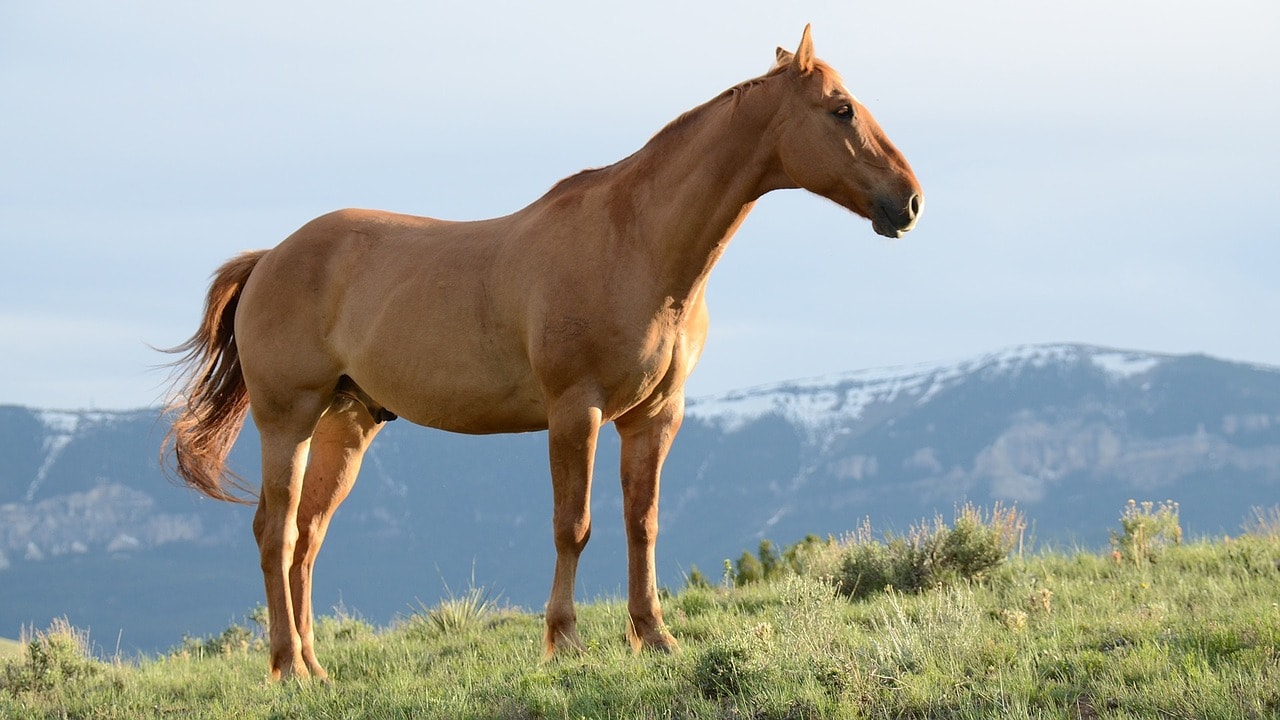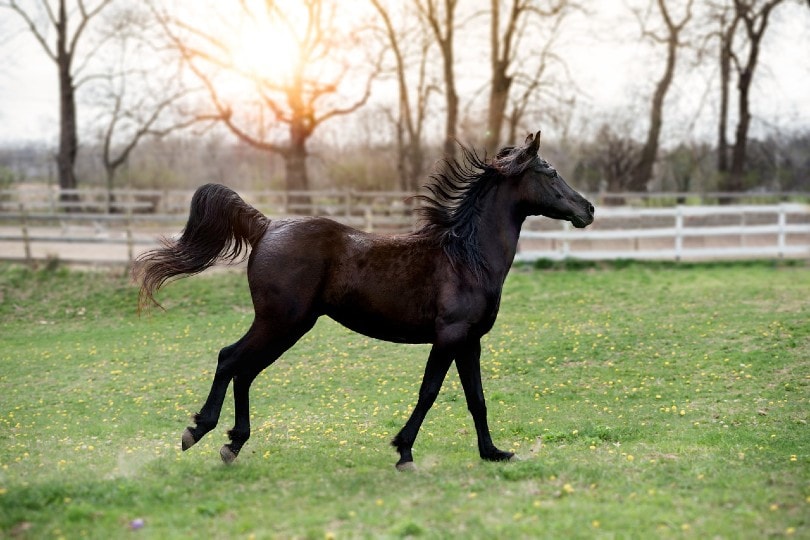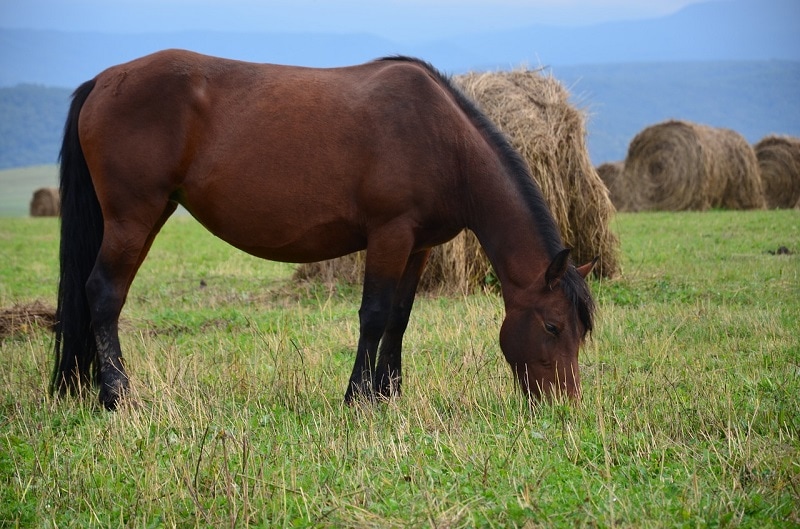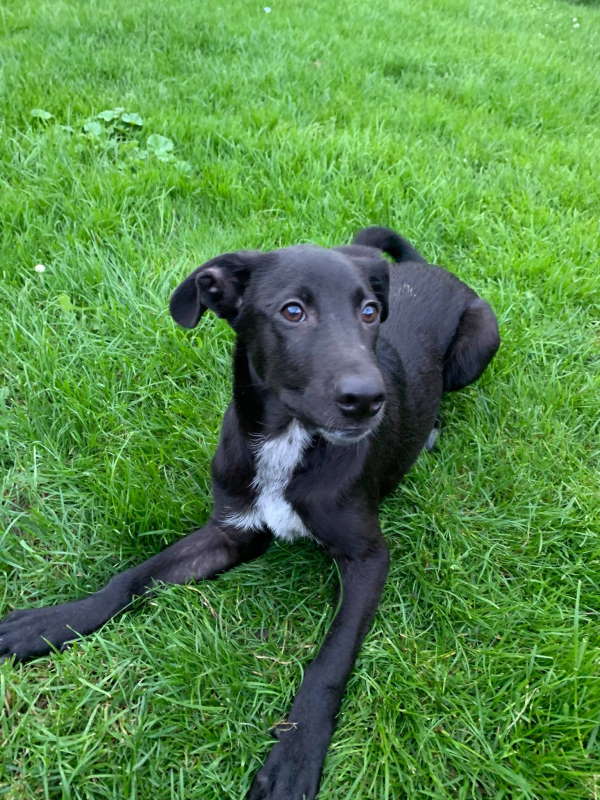

Horses are incredible creatures, capable of handling immense workloads with a level of endurance that few other animals could hope to match. No doubt, these creatures are pretty large, but you might be surprised to find out just how large they can get. Several breeds are so sizable that they weigh in excess of a ton! No joke, some horses weigh 2200 pounds or even slightly more. Granted, not every breed is capable of producing such monsters. In this article, we’ll take a closer look at how much horses weigh, discussing averages and differences between breeds along the way.

What Is the Average Weight of a Horse?
Horses come in all shapes and sizes. Some stand just 25 inches tall! Naturally, a horse of such small stature isn’t going to weigh a whole lot. On average, the smallest breed in the world, the Falabella, weighs just 165 pounds! Obviously, that’s not a clear indicator of the average horse’s weight.
For full-size horses, weights differ drastically, but most horses fall between 800 and 2200 pounds for an average weight across the board of about 1500 pounds. Smaller breeds like Quarter Horses tend to fill the lower end of the weight spectrum, while giants like Clydesdales and Shires tip the scales with weights that often surpass 2000 pounds.

Horse Breed Weight Chart
| Horse Breed | Average Weight (lb) |
| American Warmblood | 1,212–1,322 lb |
| Arabian | 793–992 lb |
| Ardennes | 1,543–2,205 lb |
| Cleveland Bay | 1,212–1,543 lb |
| Clydesdale | 1,543–1,764 lb |
| Connemara Pony | 639–860 lb |
| Dales Pony | 882–1,102 lb |
| Dartmoor Pony | 441–705 lb |
| Dutch Warmblood | 1,212–1,322 lb |
| Eriskay Pony | 661–882 lb |
| Exmoor Pony | 661–882 lb |
| Fell Pony | 772–992 lb |
| Hackney | 882–1,212 lb |
| Hackney Pony | 551–772 lb |
| Haflinger | 772–1,322 lb |
| Hanoverian | 1,212–1,433 lb |
| Highland Pony | 1,102–1,322 lb |
| Holsteiner | 992–1,764 lb |
| Irish Draught | 1,322–1,764 lb |
| New Forest Pony | 507–728 lb |
| Percheron | 1,874–2,094 lb |
| Shetland Pony | 397–441 lb |
| Shire | 1,543–2,646 lb |
| Spotted Pony | 441–882 lb |
| Suffolk Punch | 1,653–1,984 lb |
| Swedish Warmblood | 882–1,212 lb |
| Thoroughbred | 992–1,102 lb |
| Welara | 661–882 lb |
| Westphalian | 992–1,322 lb |

The Best Methods to Weigh a Horse Accurately
Clearly, a horse is far too large to stand on your little bathroom scale. Plus, those scales won’t register a 2,000-pound weight; the scale would be crushed! Weighing a horse can prove difficult for this reason, but there are three methods commonly employed to find a horse’s weight.
Weighbridge
A weighbridge is a giant set of scales that is mainly used for weighing large transports like tractor-trailers and train cars. Taking your horse on one of these scales is the easiest and most accurate way to figure out its weight, though not everyone will be able to get access to a weighbridge.
Weigh-Tape
Since weighbridges are out of reach for most people, weigh-tapes offer a convenient solution and belong in every tack box. These tapes measure around your horse’s girth to provide you with a weight measurement. You’ll need to follow the instructions carefully if you want an accurate reading.
Formula
If for some reason you can’t get access to a weigh-tape, then you can use measurements and a formula to determine your horse’s weight. This method is actually more accurate than a weigh-tape, but it takes a lot more time and effort. First, you’ll have to take a heart girth measurement, measuring your horse’s girth just behind the elbows and around the tallest point of the withers. Then, you’ll need a body length measurement from the point of one shoulder to the point of the buttock on the same side.
Next, use those measurements in the formula: (heart girth x heart girth x body length) / 330. The result will be your horse’s weight in pounds.

The Importance of Managing Your Horse’s Weight

Just like humans, dogs, cats, and any other animal, horses are susceptible to becoming overweight. This is more of a problem with horses that don’t get sufficient exercise. But weight gain for a horse can be dangerous and have a major impact on the animal’s overall health. Unfortunately, obesity is becoming a major problem in the horse industry today.
Fat stores on your horse’s body similar to how it does on a person. But fat can become hard on a horse, rocking from side to side as the horse walks. This type of fat is known as crest fat, and it can form a crest around the neck. Fat will also accumulate on the withers and backbone in an overweight horse, though these areas should be practically fat-free on a healthy horse.
Overweight horses are more likely to experience health problems and diseases. These horses are more susceptible to laminitis, equine metabolic syndrome, and insulin dysfunction. When overweight, horses can’t perform as well physically. The extra weight also causes damage to their hooves and can lead to arthritis as well.
To gauge your horse’s overall health in regards to its weight, you’ll want to perform a body condition score test. This test is easy to administer and it evaluates your horse’s fat deposits in six key areas, giving your horse a score on a scale of 0-5 with zero being a starving, scrawny horse and five being morbidly obese.
An alternative to the body condition score is to use your horse’s girth to height ratio to determine if it’s overweight or not. Start by measuring your horse’s girth and height. Then, you just divide the height measurement by the girth. The resulting number will have a decimal. If the number is 1.26 or higher, then your horse is overweight. It’s a little different for ponies as they aren’t overweight until a girth-to-height ratio of 1.33 or higher.

How to Care for An Overweight Horse
If you determine that your horse is overweight, you’ll need to provide specific care to help manage its weight and get it back down to a healthy level. Here are some tips to help you along the way.
- Ensure your horse has easy access to an endless supply of clean drinking water and salt, such as a salt block.
- Remove high-calorie feeders and supplements from the diet as the horse doesn’t need the extra energy.
- Reduce the amount of time the horse has access to the pasture; four hours per day is a good place to start.
- Start slowly increasing exercise each day. Begin with easy exercise and increase the intensity and duration over time.
- If your horse is eating legumes, switch to grass forages as they have significantly reduced caloric impact.

How to Care for An Underweight Horse
Overweight horses tend to be a bit more common than underweight horses, but if a horse is underweight, it could be susceptible to a litany of health concerns similar to an overweight horse. Luckily, it’s usually not too difficult to help an underweight horse gain a few pounds. If you find yourself caring for an underweight horse, try these steps:
- Provide constant access to hay or a pasture for grazing so your horse can eat at any time day or night.
- Switch to a more calorically dense type of forage, such as alfalfa, which generally has more calories and protein than other kinds of forage.
- Add grain into your horse’s diet if it’s not eating grain already. Try using a grain that’s intended for performance or workhorses as these contain more calories to help your horse gain weight faster.
- If you’re already feeding grain to the horse, then try switching grains to one that’s meant for performance. You want something that’s high in fat; 10%-12% is a good place to start.
- Add a high-fat supplement into your horse’s daily diet, such as flaxseed, vegetable oil, or rice bran.

Conclusion
Horses are some of the largest animals we keep as pets, companions, and partners. Though the average horse weighs 1200-1500 pounds, some giants can reach gargantuan weights of over 2200 pounds. Most of the mammoth-sized horses are drafts, such as Percherons, Clydesdales, and Shires. But don’t forget about the miniature equine breeds on the other side of the spectrum. Some of these small creatures, like the Falabella weigh well under 200 pounds and can even be lighter than the average man!
Featured Image Credit: Free-Photos, Pixabay
An avid outdoorsman, Dean spends much of his time adventuring through the diverse terrain of the southwest United States with his closest companion, his dog, Gohan. He gains experience on a full-time journey of exploration. For Dean, few passions lie closer to his heart than learning. An apt researcher and reader, he loves to investigate interesting topics such as history, economics, relationships, pets, politics, and more.






